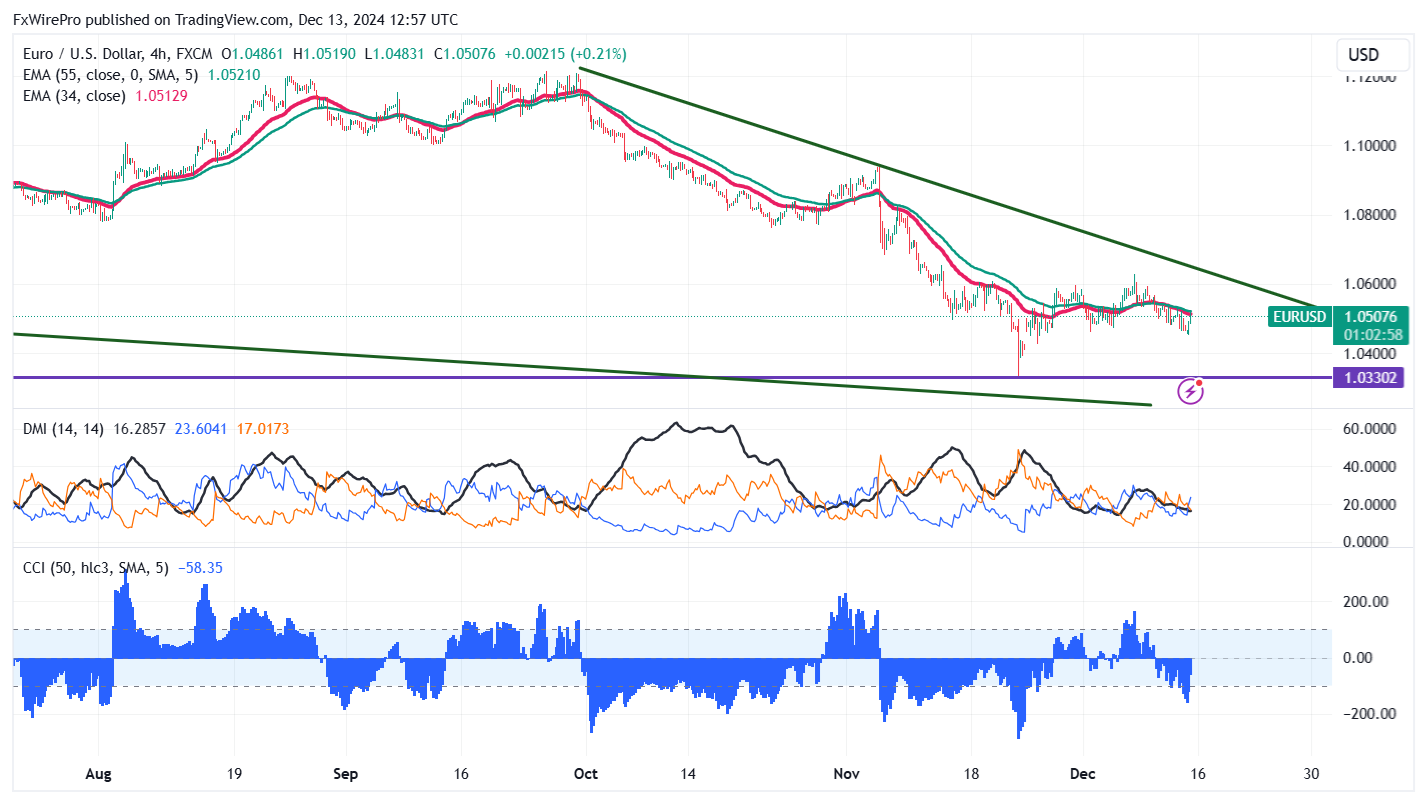EUR/USD showed a minor pullback after upbeat Eurozone data, hitting an intraday high of 1.05190 and currently trading around 1.05069.
Eurozone Industrial Production: Stability Amid Challenges
On December 13, 2024, Eurostat reported that Eurozone industrial production was stable in October compared to September, after a 2.0% drop in September. This stability matches market expectations and shows a pause in the earlier downward trend. Year-over-year, industrial output fell by 1.2% in October, which is better than the expected 1.9% decline, suggesting some improvement. Different sectors showed mixed results: the capital goods sector saw an increase, while energy production faced challenges and declined. In the broader EU, industrial production increased by 0.3% in October, bouncing back from a 1.4% decline in September. This mixed performance indicates ongoing economic pressures but also some resilience, which may impact future decisions by the European Central Bank (ECB) as it considers how to support economic recovery amid changing inflation and growth rates.
Monetary Policy Divergence: Fed vs. ECB
As of December 2024, the Federal Reserve (Fed) and the European Central Bank (ECB) are taking very different approaches to their monetary policies. The Fed is cautious about cutting interest rates, planning only one cut this year due to ongoing inflation and a strong job market. In contrast, the ECB has cut its key interest rate by 0.25% to 3.00% to address low growth and cooling inflation in the Eurozone. This difference may weaken the euro against the dollar as investors seek higher returns from U.S. assets. Additionally, the weaker euro could increase import prices in Europe, complicating the ECB's inflation management. Overall, these contrasting policies reflect the unique economic challenges facing each region.
Technical Analysis: Resistance and Support Levels
The pair remained below both short-term (34 and 55-4H EMA) and long-term (200-4H MA) moving averages. Near-term resistance is at 1.0550, and a breakout above this could push the pair towards targets at 1.0600, 1.0660, 1.070, 1.0760, and possibly 1.0900. Major bullish momentum is expected only if prices surpass 1.1000, which would open the door to 1.1070 and 1.1150. On the downside, immediate support is at 1.0460; a drop below this could lead to further declines to 1.0435, 1.0400, 1.0370, 1.0330, and 1.0240.
Indicator Insights: Trading Strategy Recommendations
The Commodity Channel Index (CCI) indicates a bullish trend, while the Average Directional Movement Index (ADX) suggests a neutral outlook. Given the weak sentiment in technical indicators, a sensible strategy would be to buy on dips around the 1.0500 mark, with a stop-loss at 1.0460 and a target price of 1.0600/1.0660 for potential gains.



 FxWirePro- Major US Indices
FxWirePro- Major US Indices  FxWirePro: GBP/USD dips below lower range, bearish bias increases
FxWirePro: GBP/USD dips below lower range, bearish bias increases  FxWirePro :EUR/NZD loses momentum but outlook is bullish
FxWirePro :EUR/NZD loses momentum but outlook is bullish  Gold Prices Retreat as Strong Dollar Prevails and Economic Data Mixed: A Trading Strategy for Market Movements
Gold Prices Retreat as Strong Dollar Prevails and Economic Data Mixed: A Trading Strategy for Market Movements  FxWirePro: USD/ZAR maintains bullish bias with focus on 18.000 level
FxWirePro: USD/ZAR maintains bullish bias with focus on 18.000 level  FxWirePro: GBP/USD falls on disappointing UK GDP data, plunge to test a key fibo grows
FxWirePro: GBP/USD falls on disappointing UK GDP data, plunge to test a key fibo grows  FxWirePro: EUR/CAD downside pressure builds, key support level in focus
FxWirePro: EUR/CAD downside pressure builds, key support level in focus  FxWirePro: NZD/USD poised for further downside ,eyes 0.5700 level
FxWirePro: NZD/USD poised for further downside ,eyes 0.5700 level  FxWirePro: USD/ JPY remains bullish as rally continues
FxWirePro: USD/ JPY remains bullish as rally continues  FxWirePro: USD/CAD bulls undeterred, eyes 1.4300 level
FxWirePro: USD/CAD bulls undeterred, eyes 1.4300 level  FxWirePro- EURGBP Trade Idea
FxWirePro- EURGBP Trade Idea  FxWirePro- EURJPY Trade Idea
FxWirePro- EURJPY Trade Idea  FxWirePro-Major European Indices
FxWirePro-Major European Indices  FxWirePro: USD/ JPY loses momentum but bullish setup remains
FxWirePro: USD/ JPY loses momentum but bullish setup remains  FxWirePro- Major pair levels and bias summary
FxWirePro- Major pair levels and bias summary  FxWirePro: USD/CAD sustains gains as uptrend remains strong
FxWirePro: USD/CAD sustains gains as uptrend remains strong  FxWirepro- Woodies Pivot (Major)
FxWirepro- Woodies Pivot (Major) 































